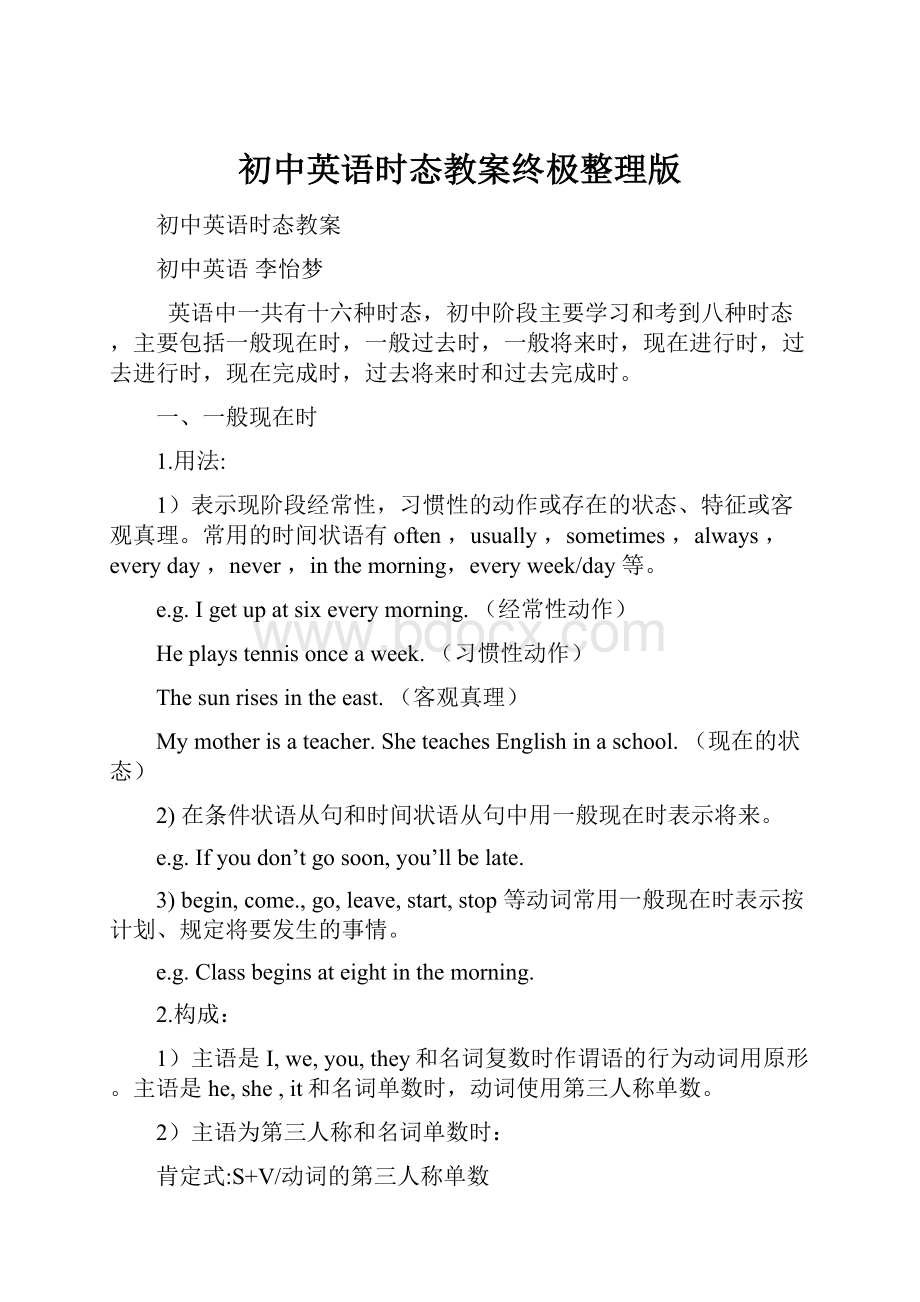初中英语时态教案终极整理版.docx
《初中英语时态教案终极整理版.docx》由会员分享,可在线阅读,更多相关《初中英语时态教案终极整理版.docx(13页珍藏版)》请在冰豆网上搜索。

初中英语时态教案终极整理版
初中英语时态教案
初中英语李怡梦
英语中一共有十六种时态,初中阶段主要学习和考到八种时态,主要包括一般现在时,一般过去时,一般将来时,现在进行时,过去进行时,现在完成时,过去将来时和过去完成时。
一、一般现在时
1.用法:
1)表示现阶段经常性,习惯性的动作或存在的状态、特征或客观真理。
常用的时间状语有often,usually,sometimes,always,everyday,never,inthemorning,everyweek/day等。
e.g.Igetupatsixeverymorning.(经常性动作)
Heplaystennisonceaweek.(习惯性动作)
Thesunrisesintheeast.(客观真理)
Mymotherisateacher.SheteachesEnglishinaschool.(现在的状态)
2)在条件状语从句和时间状语从句中用一般现在时表示将来。
e.g.Ifyoudon’tgosoon,you’llbelate.
3)begin,come.,go,leave,start,stop等动词常用一般现在时表示按计划、规定将要发生的事情。
e.g.Classbeginsateightinthemorning.
2.构成:
1)主语是I,we,you,they和名词复数时作谓语的行为动词用原形。
主语是he,she,it和名词单数时,动词使用第三人称单数。
2)主语为第三人称和名词单数时:
肯定式:
S+V/动词的第三人称单数
否定式:
S+don't/doesn't+V+其他
疑问式:
Do/Does+S+V+其他
简略回答:
(肯)Yes,S+do/does
(否)No,S+do/doesnot
主语
肯定式
否定式
疑问式
第一、二人称和第三人称复数以及名词复数
Iamastudent.
We/You/Theyarestudents.
He/Sheisastudent.
I/We/You/They/likemusic.
Manypeoplelikemusic.
Iamnotastudent.
We/You/Theyarenotstudents.
He/Sheisnotastudent.
I/We/You/They/don’tlikemusic.
Manypeopledon’tlikemusic.
Areyouastudent.
Areyou/theystudents?
Ishe/sheastudent?
Doyou/theylikemusic?
Domanypeoplelikemusic?
3)当主语是第一、二人称和第三人称复数以及名词复数时:
肯定式:
S+be+···
否定式:
S+be+not+···
疑问式:
Am/Is/Are+S+···?
简略回答:
(肯)Yes,S+be.
(否)No,S+be.
真题:
1.——Canyourfatherdrive?
(08武汉)
——Yes,andheusuallytoschool.
AdroveBisdrivingCdrivesDhasdriven
2.IfIfindhisphonenumber,Iyou.(09北京)
AtellBtoldCwilltellDhavetold
3.Theteachertoldthestudentsthattheearthround,notflat.(08天津)
AisBwasChasbeenDisbeing
二、一般过去时
1.表示过去某段时间发生的事,存在的状态或过去反复发生的动作时用一般过去时。
常用于一般过去时的时间状语:
yesterday,threemonthsago,lastyear,in1979等。
2.用法:
1)过去发生的动作。
e.g.Thepolicestoppedmeonmywayhomelastnight.
2)过去存在的状态。
e.g.Theyweren'tabletocomebecausetheyweresobusy.
3)beusedtodoing表示过去常常做某事。
也是一般过去时的标记。
e.g.Shewasusedtofeedingthecatsintheyard.
3.构成:
S+V-ed
1)用动词的过去式。
作谓语的行为动词的词尾变化如下:
一般情况
+ed
以e字母结尾的辅音
+d
以辅音字母+y结尾
去y变i+ed
重读闭音节结尾的单词,末尾只有一个辅音字母
双写词尾字母+ed
2)一般过去时态的肯定句、否定句和疑问句形式(以be和like为例):
主语
肯定式
否定式
疑问式
第一、二人称和第三人称复数以及名词复数
Iwasastudent.
We/You/Theywerestudents.
He/Shewasastudent.
I/We/You/They/likedmusic.
Manypeoplelikedmusic.
Iwasnotastudent.
We/You/Theywerenotstudents.
He/Shewasnotastudent.
I/We/You/They/didn’tlikemusic.
Manypeopledidn’tlikemusic.
Wereyouastudent.
Wereyou/theystudents?
Washe/sheastudent?
Didyou/theylikemusic?
Didmanypeoplelikemusic?
真题:
1.Yesterday,Tony’sfamilyagoodtime.(08泸州)
AhasBhaveChad
2.WewereinQingdaolastweekandgreatfunthere.(08北京)
AwillhaveBhavehadChadDhave
3.MygrandmotherusstorieswhenIwasyoung.(09锦州)
AwasusedtotellBisusedtotellingCareusedtotellDwasusedtotelling
三、一般将来时
1.用法:
表示将来某个时间要发生的动作或存在的状态,常用于一般将来时的时间状语:
tomorrow,nextweek,in2008等。
1)将要发生的动作。
e.g.IwillleaveforBeijingtomorrow.
2)将要存在的状态。
e.g.ThistimenextyearIwillbeinJapan.Wherewillyoube?
3)打算要做的事。
e.g.Areyougoingtowatchthefilmontelevisiontonight?
4)come,go,start,move,sail等动词常用进行时态表示按计划将要发生的事。
e.g.Thewholefamilyisgoingfortwomonths.
5)在条件状语从句和时间状语从句中用一般现在时表示将来。
e.g.Ifyoudon’tgosoon,you’llbelate.
2.构成:
1)助动词will(shall)+v
2)be+goingto+v
3.will和begoingto的区别:
1)表示带意愿色彩的将来用will。
e.g.Iwillstaywithyouinthefuture.
2)询问对方是否愿意或表示客气的邀请和命令时用will。
e.g.Willyougototheparkwithme?
Willyoupleaseopenthedoor?
3)表示客观的将来,用will。
e.g.Iwillbe22yearsoldnextyear.
4)begoingto常用于口语中用来表示即将发生的动作或存在的状态。
e.g.We’regoingtohelpsomefarmerswiththeirwork.
5)表示打算或准备要做的事用begoingto
e.g.She’sgoingtoleaveat10o’clocktomorrow.
6)根据某种迹象判断可能要发生的事用begoingto。
e.g.Lookattheclouds.It’sgoingtorain.
真题:
1.——Whyareyouinsuchahurry,Mike?
(09福州)
——ThereanNBAbasketballgameintenminutes.
AwillhaveBwillbeCisgoingtohaveDaregoingtobe
2.Infiveyears,Iadoctor.(08泸州)
AwillbeBwasCam
3.Iftheycome,weameeting.
AhaveBwillhaveChadDwouldhave
四、现在进行时
1.用法:
1)说话时正在进行或发生的动作(动作是在说话时正在进行)。
常用于现在进行时态的时间状语:
now,look,listen等。
e.g.Sheishavingabathnow.
2)现阶段正在进行或发生的动作(但是动作并不是必须在说话时正在进行)。
e.g.Youareworkinghardtoday.
KatewantstoworkinItaly,sosheislearningItalian.
Thepopulationoftheworldisgrowingveryfast.
3)频度副词always,forever等词连用时,表示某种强烈的感情。
e.g.Heisalwaystryingoutnewideas.
4)表示按计划即将发生的动作(仅限于go,come,arrive,leave,start,fly,begin,stay等动词)。
e.g.Thepartyisbeginningat8:
00o’clock..
5)“系动词+介词/副词”表示正在进行的动作。
e.g.Heisatwork.
6)表示感觉、愿望和状态的某些动词如hope,smell,hear,see等一般不用进行时态。
2.构成:
be+v-ing
1)v-ing现在分词的构成:
一般情况
cook-cooking
以不发音字母e结尾的单词。
去e,加ing
make-making,taste-tasting
以重读闭音节结尾的单词,末尾只有一个辅音字母时.
run-running,stop-stopping,
2)肯定句、否定句、疑问句形式:
肯定句:
S+be+V-ing
否定句:
S+be+not+V-ing
一般疑问句:
Is(Are)+S+V-ing?
特殊疑问:
wh_+be+S+V-ing?
主语
肯定式
否定式
疑问式
第一、二人称和第三人称复数以及名词复数
Iamdriving.
He/She/Itisworking.
We/You/Theyaredoingsomething.
Iamnotdriving.
He/She/Itisnotworking.
We/You/Theyarenotdoinganything.
Areyoudriving?
Ishe/she/itworking?
Areyou/theydoingsomething?
真题:
1.Mr.Greentothemanagernow.You’dbettercallhimlater.(09北京)
AtalkBistalkingCtalkedDwastalking
2.Everythingontheearthallthetime.
AischangingBischangedChaschangedDhasbeenchanged
3.Bequiet,please.Thestudentsaclassnow.(08长春)
AhaveBhadCarehavingDwerehaving
五、过去进行时
1.用法:
过去某一阶段或某一时刻正在进行的动作。
常用于过去进行时的时间状语有atfouryesterdayafternoon,then,atthattime/moment等。
e.g.ThistimelastyearIwaslivinginBrazil.
Whatwereyoudoingat10o'clocklastnight?
2.构成:
was/were+v-ing
3.一般过去时和过去进行时的区别:
1)一般过去时:
强调过去某个时候曾有过某个动作(已经完成的)。
2)过去进行时:
强调动作在过去的某个时候或某个时间段内正在进行(是否完成不明确)。
e.g.Marywrotealettertoherfriendlastnight.
Marywaswritingalettertoherfriendlastnight.
真题:
1.——Wereyouathomeat7o’clocklastnight?
(09宁波)
——Yes,Iashoweratthattime.
AtookBamtakingCwastakingDwastaken
2.TheboydownthestreetwhentheUFOlanded.(09仙桃)
AwalksBwalkCiswalkingDwaswalking
3.ImyhomeworkwhilemyparentsTVlastnight.(06南京)
Adid;havewatchedBwasdoing;werewatching
Chaddone;werewalkingDwoulddo;werewatching
六、现在完成时
1.用法:
1)表示过去发生或已经完成的动作对现在造成的影响或结果,常与already,just,ever,never,before等副词连用。
e.g.Shehasneverreadthisnovel.
2)表示“过去的动作”一直延续到现在并有可能继续延续下去。
常与for(后跟段时间)或since(后跟点时间)等连用。
e.g.IhavebeenamemberofthePartyfor10years.
IhavebeenamemberofthePartysince10yearsago.
3)在有for和since引导时间状语的句子中不能用短暂性动词(die,arrive,close,become,come,fall,leave,go,lose,give,jump),应用与之相应的表示状态的词。
e.g.(F)Hehasdiedfor3years.
(T)Hehasbeendeadfor3years.
4)当表示动作、状态持续时用延续性动词(work,stand,know,walk,keep,have,wait,watch,read,sleep)。
延续性动词一般不与表示“点”的时间状语连用。
e.g.WehavestudiedEnglishforthreeyears.
(F)Itrainedateightyesterdaymorning.
(T)Itbegantorainateightyesterdaymorning.
2.构成:
1)have/has+v-ing
2)现在完成时态的肯定句、否定句和疑问句形式(以be和see为例):
肯定句:
S+have(has)+V-ed
否定句:
S+have(has)+not(haven’t,hasn’t)+V-ed
一般疑问句:
Have(Has)+S+V-ed+?
特殊疑问句:
wh_+have(has)+S+V-ed+?
主语
肯定式
否定式
疑问式
第一、二人称和第三人称复数以及名词复数
I/We/You/Theyhavebeenherebefore.
He/Shehasbeenherebefore.
.I/We/You/They/Manypeoplehaveseenthefilm.
I/We/You/Theyhaven’tbeenherebefore.
He/Shehasn’tbeenherebefore.
.I/We/You/They/Manypeoplehaven’tseenthefilm.
Haveyou/theybeenherebefore?
Hashe/shebeenherebefore?
Haveyou/they/manypeopleseenthefilm?
3.现在完成时与一般过去时的区别
1)侧重点不同。
现在完成时强调过去的动作对现在造成的影响;一般过去时只是一种过去的时态,与现在无关。
e.g.YesterdayIwenttothezoo.
LiLeihasreadthebook.
2)标记的时间状语不同。
现在过去时:
already,yet,still,just,sofar,before,ever,never,since+一段时间,for+一段时间。
一般过去时:
ago,yesterday,lastyear,in2000,justnow.
e.g.Haveyoueverpickedflowersorsteppedonthegrassinapark?
Fatherboughtthatwatchtenyearsago.
4.havebeento,havegoneto,havebeenin的区别
1)havebeento表示过去曾去过某地,现在已经不在该地了。
常与just,ever,never等连用,后面可接次数,表示去过某地几次。
e.g.HehasbeentoGuangzhouforthreetimes.
——HaveyoueverbeentotheUnitedStates?
——Yes,twice.
2)havegoneto表示到某地去了,说话时该人不在说话地点,或者已到该地,或在途中。
一般主语不用第一、第二人称。
e.g.——WhereisMrs.Smith?
——Sheisn’there.ShehasgonetoEngland.
3)havebeenin表示已经在某地待了多久。
常跟for+一段时间,表示在某地待了多长时间。
e.g.——HaveyoursisterbeeninChinaforalongtime?
——Yes.Shewenttherefiveyearsago.
DavidhasbeeninShanghaiformorethanthreemonths.
真题:
1.——HowdoyoulikeBeijing,Mr.Smith?
——Oh,Isuchabeautifulcitybefore.
Adon’tvisitBdidn’tvisitChaven’tvisitedDhadn’tvisited
2.Sheasananimaltrainersince2003.(09北京)
AhasworkedBworksCwillworkDworked
3.——IsMr.Greenathome?
(09黔东)
——No,heShanghai.
AhasbeentoBhasgonetoCisgoingto
4.——WhereisZhangMing?
(10.湖南)
——Oh,don’tyouknowhetoBeijingtoseehisparentsandhe’llbebacktomorrow.
A.hasgoneB.hasbeenC.hadgone
5.——Jack,Ihaven’tseenyourbrotherforalongtime.(09,福建)
——HeShanghaionbusinessfortwomonths.
A.wenttoB.hasgoneto
C.hasbeeninD.hasbeento
七、过去将来时
过去将来时表示从过去某个时间看将要发生的动作或存在的状态,“从过去看将来”,常用于宾语从句。
1.用法:
1)主句为一般过去时,宾语从句表示将要发生的事情。
e.g.Nobodyknewwhatwouldhappenafterahundredyears.
2)叙述过去的事情或事情发生的经过时,用过去将来时表示在当时看将会发生的事。
e.g.ItwasonSu